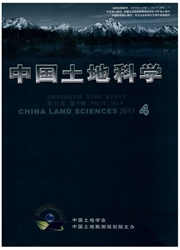

 中文摘要:
中文摘要:
研究目的:基于土地系统科学基础理论,研究提出全国土地系统观测研究网络的功能定位、组织架构、协同创新机制,形成土地系统综合观测技术研发、“大数据”平台构建、土地系统观测研究基地建设和网络优化布局的总体思路,搭建土地系统综合观测理论一技术一平台一机制创新架构,提出全国土地系统观测研究网络建设的战略框架。研究方法:文献研究、专家访谈、实地调研。研究结果:(1)土地系统是由人文和自然要素构成的人地关系时空系统。土地系统研究的核心是系统各要素动态变化、互馈机制,人一地系统功能演变、协同耦合与优化调控机理。土地系统具有多级、综合、动态性特征,建设土地系统多级综合观测网络,开展持续观测,是加强土地系统科学认知的有效途径。(2)土地系统多级综合观测研究网络建设要围绕数据观测、科学研究、政策创新、资源共享、人才培养、教育科普等功能,形成全国一区域一县域一村镇土地科技创新多级协同组织架构;创新联合共建、人才交流、科研联动、资金保障、数据共享、成果转化等协同机制,完善运行管理制度体系;围绕主要科学问题和研究领域,研发土地系统综合观测指标和观测技术体系,构建土地系统综合监测数据管护服务平台;加强科学观测研究基地建设,优化全国土地系统综合观测网络布局,形成全国、区域、市县、村镇、地块多层级观测体系。研究结论:建设全国土地系统观测研究网络,加强土地系统科学协同创新,可为土地科技联合攻关,土地系统跨尺度、多要素、全方位的科学认知,土地系统科学发展和科学、系统、联动、高效的土地管理科学决策提供有效支撑。
 英文摘要:
英文摘要:
The purpose of this study is to define the functions, organizational framework and cooperative innovation mechanism of China Land System Observation and Research Network (CLSORN) based on land system science theories, and to put forward general ideas of land system observation technologies system, data management system, land system observation and research bases construction and network distribution, and to construct the framework for land system comprehensive observation theory, technology, platform and mechanism innovations as well as to build the strategic framework for CLSORN. The methods include literature research, expert interview and fieldwork. The results show that: 1 ) Land system is a spatiotemporal system of human-land relationship, which is composed of human and natural factors. The core of the land system research is the dynamic changes of land system factors, interaction mechanism among factors and the coupling and control mechanism between human and land. Land system is hierarchical, dynamic and comprehensive, and implementing continuous observation is an effective way to enhance the land system scientific cognition. 2)The functions of CLSORN are land system data observation, scientific research, policy innovation, scientific research resource sharing, staff training, education, and popularization of land science. The contents of CLSORN construction focus on: building hierarchal, synergetic organization framework to link land science and technology innovation among national-regional- county-town/village levels; innovating mechanisms of joint construction, staff exchange, synergic research, sustainable investment, data sharing, and joint investigation to formulate CLSORN operation management policies; against key scientific and research fields, developing indicators and technologies system and web-based data system for land system integrated observation; and optimizing distribution of scientific observation and research bases to form the hierarchal network with above levels. The conclu
 同期刊论文项目
同期刊论文项目
 同项目期刊论文
同项目期刊论文
 期刊信息
期刊信息
